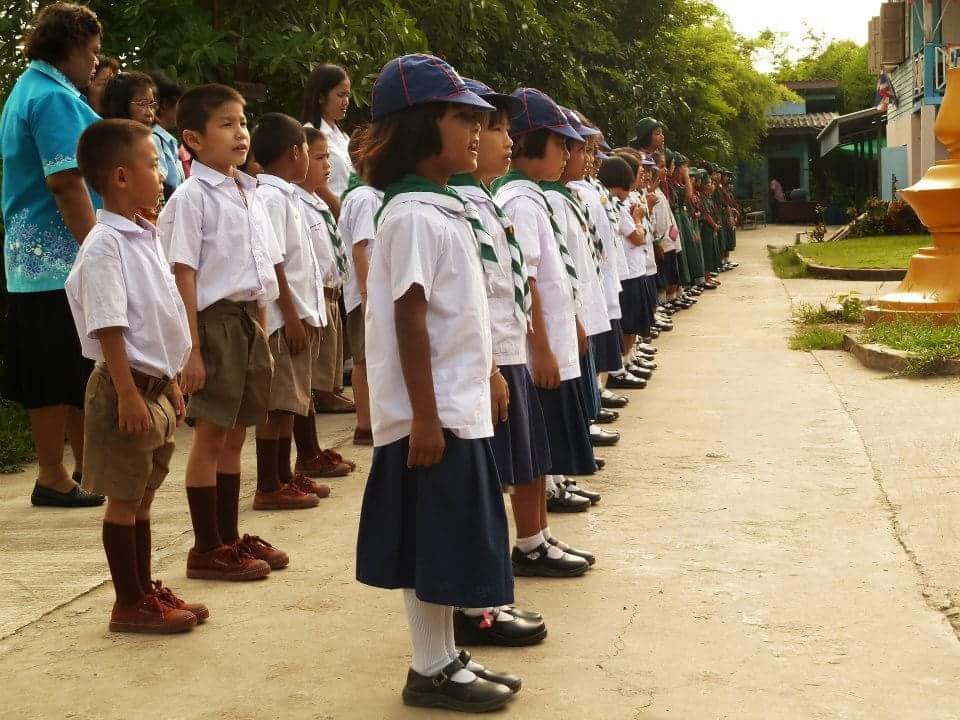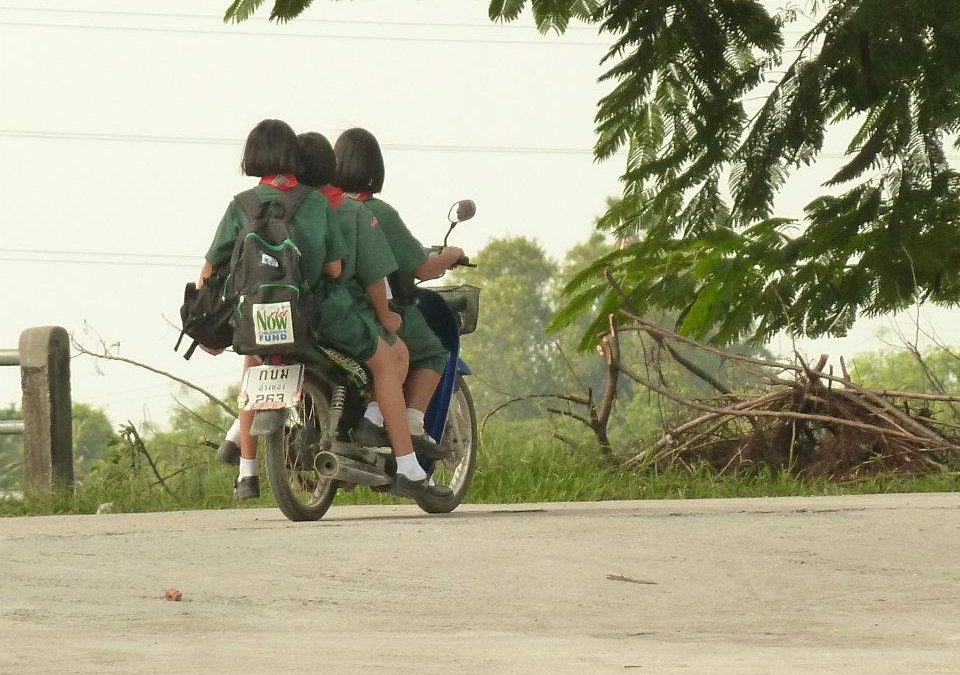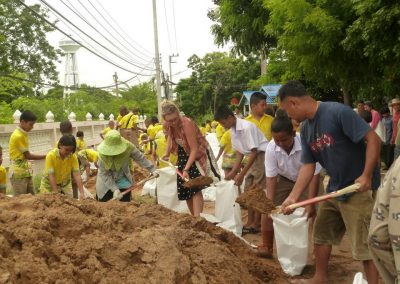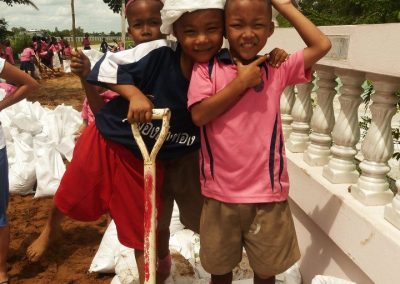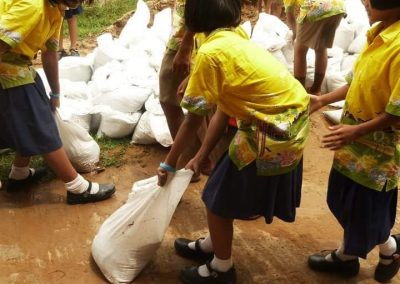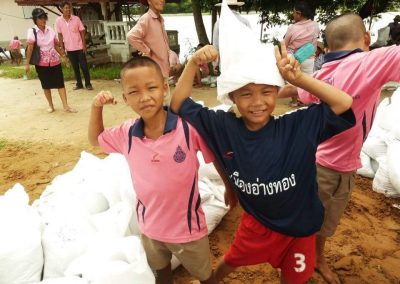The flood
I placed my book down on the floor to get up to go to the bathroom, but when I stepped off the bed, instead of my feet touching the cold stone floor, they splashed into water. I looked up and realised my book was floating out of the door.
The four of us were in Thailand to teach English at Wat Tan Ched Cho School, a small rural primary school in the province of Angthong (pronounced Ang-tong), about an hour north of Bangkok.
We were staying with a ‘host’ family – a woman in her 50s called Sumatra and her husband Narong. Sumatra spoke very little English and made deep grunting noises as she shuffled about the house in her slippers, while her husband spoke good English but was the more shy of the two, only appearing at mealtimes.
I had very little knowledge of what the living situation would be like in Thailand, and so I’d mentally prepared myself for staying in very basic, small accommodation.
Sumatra and Narong’s house was, to my shock, about three times as large as my parents’ house and even had mod cons like televisions and a washing machine.
A lot of the house was open to the outside; the kitchen, for example, was under a porch on the outside of the building (presumably so the heat from the stove could easily escape rather than be trapped in the house). The upstairs bathroom had pink brick walls with large spaces in it – the sort of brickwork you see on garden walls here in the UK – so it wasn’t out of the ordinary to be sharing a morning shower with a frog or a family of spiders. This often led to a lot of shrieks at 7am from Gabi who wasn’t overly fond of anything with more than four legs.
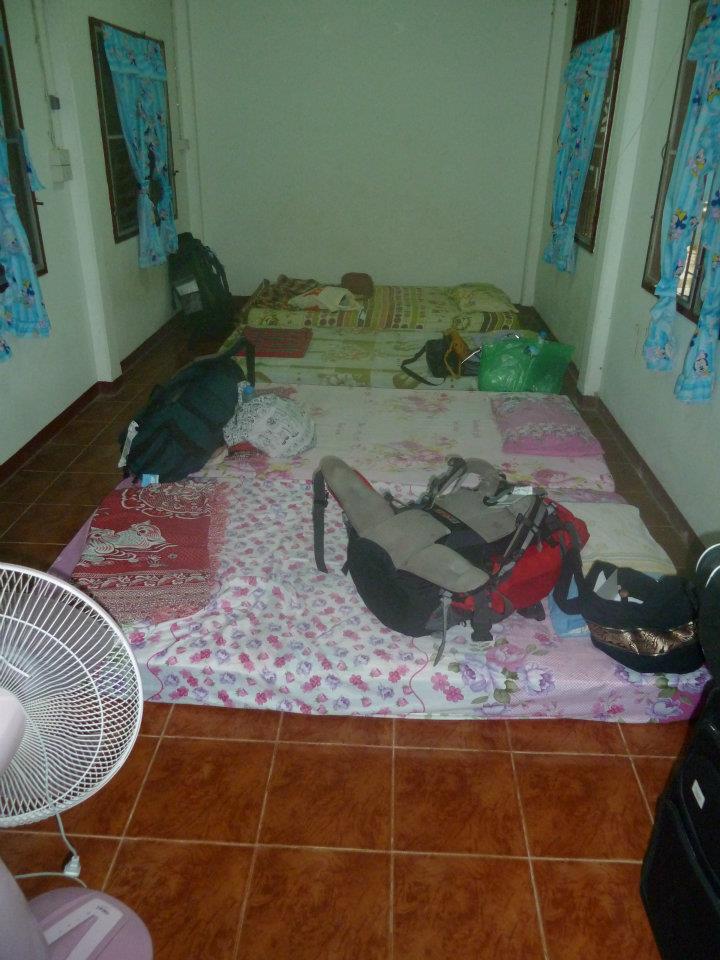
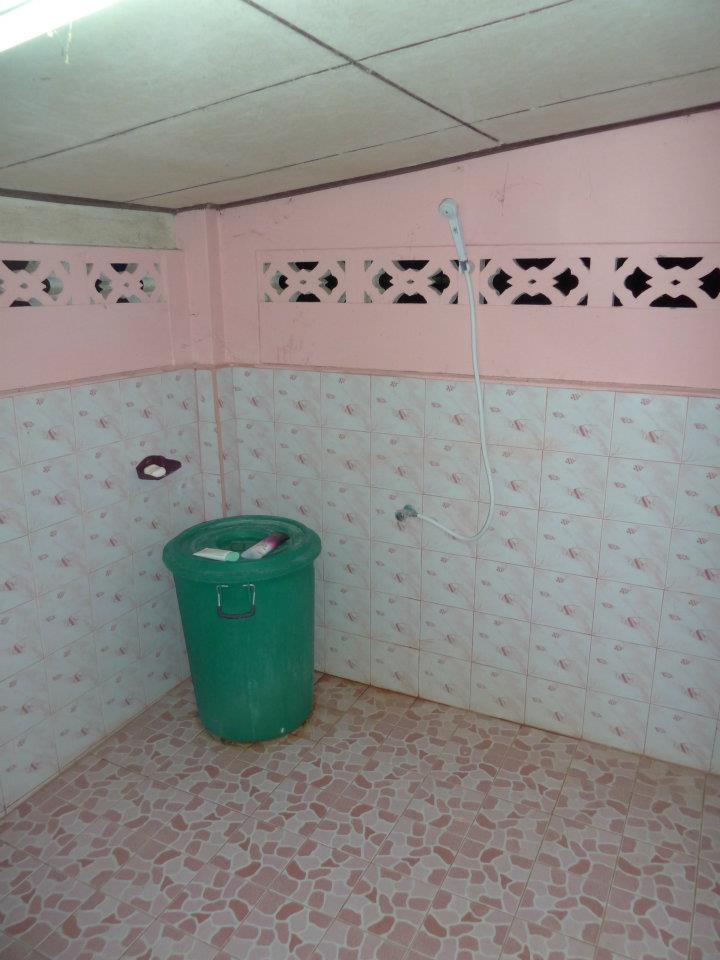
“Oh no! ” she exclaimed, a sullen look on her face. “I sorry!”
Her eyes darted to our wooden beds which were now almost covered with water, “I so sorry!”
In a mad rush we picked up all our belongings from the makeshift wooden beds and started piling them onto the tall furniture to get them out of the way. We then scoured the bottom floor of the house with Narong, moving anything else that needed to be rescued from the rising waters.
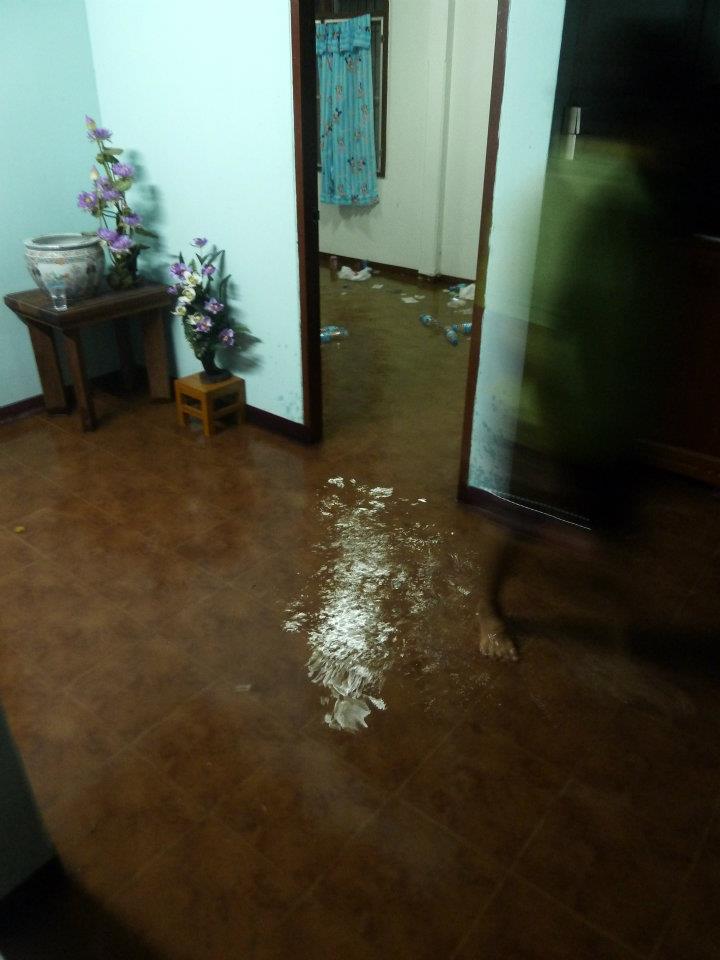
The floodwaters enter the house, and our host desperately runs around trying to move things that are valuable.
“I sorry!” said our host again, bashing her head with her hands in a very Dobby the House Elf-esque way. We had to keep telling her that it was okay, the flood wasn’t her fault, but I suppose I would be just as apologetic if I had guests at my house and they went swimming without wanting to.
Once everything that needed to be moved was safely stowed away, she curled her index finger at us and pointed to the dark wooden staircases: “You come upstairs!”
Clutching our dripping backpacks, we followed her up the stairs, and she led us down a dark wood-panelled corridor to a room at the end of the house and motioned for us to go in.
Inside, at opposite ends of the room, were two large double beds.
Real beds.
With real mattresses.
We said thank you and put our bags down, and set about to try and dry our things as best we could (I held my book in front of a fan for half an hour), but I still couldn’t understand. Why had it taken a flood for us to be allowed to sleep in actual beds? Did she forget that these were here? L Or are they only kept for ‘special’ guests?
Dealing with the impeding flood at school
Each day we would cycle a few miles alongside the Chao Phraya river to school. It was a lovely way to get to the school each morning, but it was rather a challenge; there was always a scramble between the four of us in the mornings to get the best bikes.
Now when I say ‘best’, what I really mean is least awful – most of them had flat tyres, some didn’t have working brakes, while others had seats locked into position at the highest point, and could only be mounted by climbing atop the outside washing machine and climbing onto the saddle, giving you a great appreciation for what it must be like to ride a penny farthing.
The morning after the flood, we hopped on our bikes (literally), and set off to school. The waters had receded in the night, but you could still see water marks on the sides of buildings as we cycled past, and lots of areas of grassy land were now boggy swamps.
At the school assembly the headteacher announced that we’d all stop lessons at midday – much to the children’s delight and followed by a huge cheer – and would instead go outside to help build a dam against the river.
At noon, a bell sounded across the school and everyone filed out, running towards the road next to the river where several flatbed trucks had parked, driven by Angthong residents who had all joined us in a bid to save the town.
The other teachers kept the children back while the trucks dumped several tonnes of sand into piles on the pavement. The four of us were handed a spade each and began shovelling the sand into sandbags, held open by the school children.
Pictured below: the rising waters of the river, four feet higher than normal.
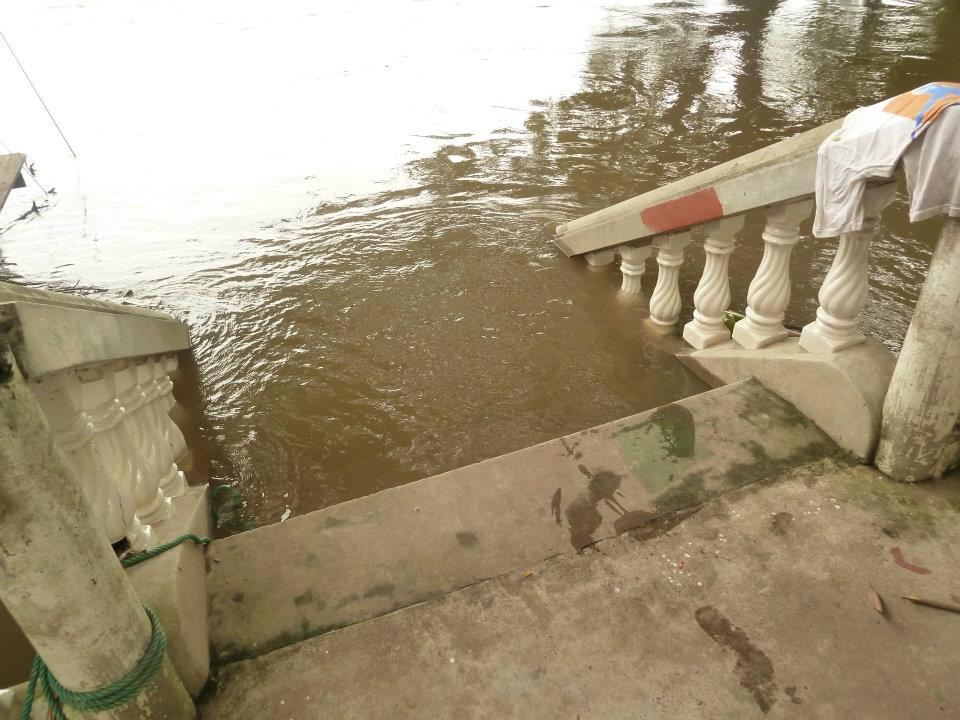
After two hours of digging, I put the spade down and looked at my hands. They were red raw and starting to blister. I was just thinking about taking a rest under a nearby tree, when a 7-year-old boy wearing a sandbag on his head picked up the shovel (which was about the same size of him) and started hacking away at the sand, attempting to lift some up.
It was far too heavy for him, but he kept on trying to lift it, making noises like ‘Hhgggggg’ and flicking little bits of sand in the air before trying again.
What was I doing? I couldn’t think about taking a break now. If I took a break, then the children would try and do the hard work, and that just wasn’t fair.
I took a swig of lukewarm water from my bottle and carried on.
The children were all doing a great job of helping distract us, opening up sandbags and cheering us on, making silly faces and saying ‘Teacher! Teacher!’ so that we’d look their way and hopefully laugh.
After three hours, we’d filled around 100 sandbags between us, enough to make a wall about four sandbags high along the riverbank, to be used at the bend in the river where the riverbank dips at its lowest.
We cheered and high fived each other (I think every child in the school came up to us to give us a high five, which was very sweet, but my god did it hurt my red raw hands) and were then handed something in a plastic bag and told we could go home. I unwrapped it and saw it was warm corn-on-the-cob. Quite an odd snack to hand out on a hot day, I thought, but it was very welcome all the same.
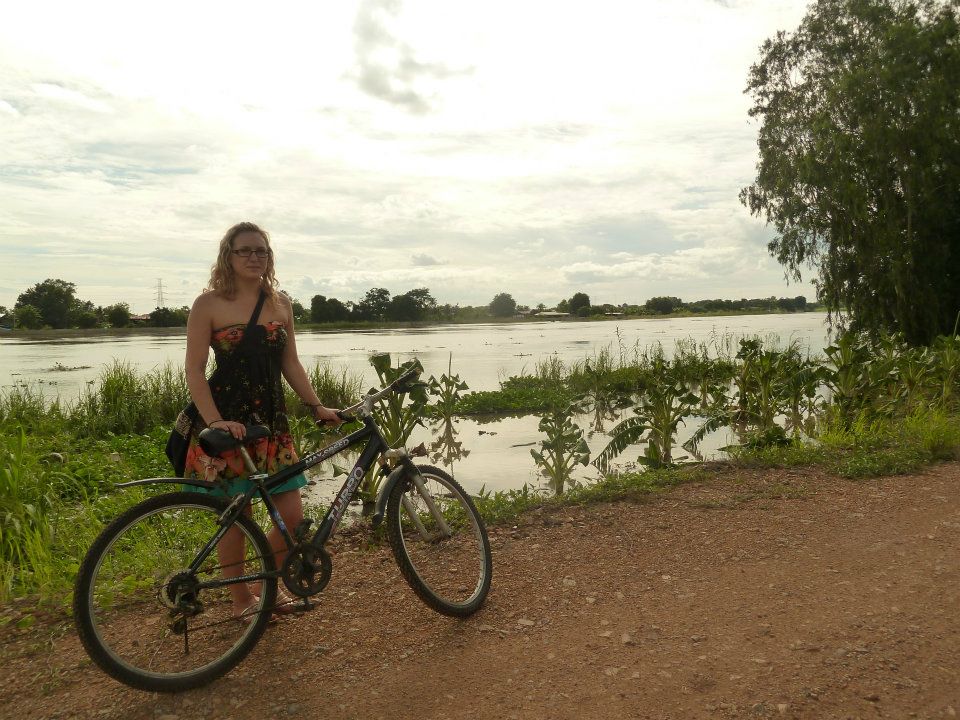
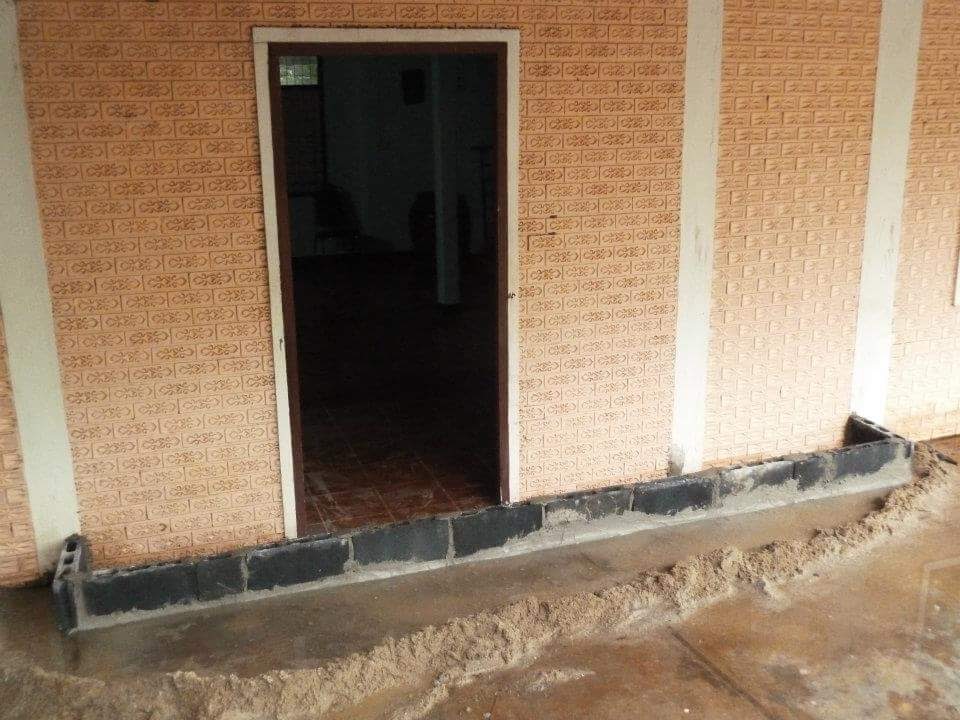
Once we’d put the bikes away, we saw that Narong had cemented a little wall around the front door as a barrier against the floodwaters, and Sumatra had gone out of her way to make a larger dinner than usual (I think as another way of apologising for the flooding). Now when I went to Thailand I was a strict vegetarian, and in the half-day intense training on the Thai language we had in Bangkok at the start of our trip I’d made sure that I knew how to say, ‘I’m a vegetarian’ and ‘I don’t like spicy food’ – the two most used phrases on my entire trip.
I’m not sure if vegetarian means something different in Thai to English, but I ended up being served fish almost every day, so I’d politely leave it on the side of my plate, untouched. Instead, I’d eat the tempura vegetables and scrambled egg, which were delicious but I later found out had been cooked in fish sauce. Breakfast was the most entertaining – in a bid to make us feel ‘at home’, we had a small selection of western food for breakfast, while Sumatra and Narong had rice and curry. The selection included out of date chocolate muffins from the local shop, cold fried eggs and cold deep-fried banana.
The next day we were in reception for the morning before we had to go back outside to shovel sand. Reception was easily the best class to teach, because ‘teaching’ meant playing games with a class of three and four-year olds for two hours. One little girl made me draw her pictures which she could then colour in, but every time I went to stand up to play with someone else I’d feel a small tug at the bottom of my dress and she’d point to the paper and then point to me, and I’d inevitably stay to draw her another picture.
What I found curious was that all of children in reception were covered from head to toe in white powder in the afternoons. At first, I thought one of them had spilt something and I offered to help clear it off, but then I noticed that all of them had this white powder on them, and it happened every day. I presumed that it had something to do with preventing oily skin and the humidity, but I never asked, I just enjoyed seeing the children running round looking like they’d fallen into a sack of flour.
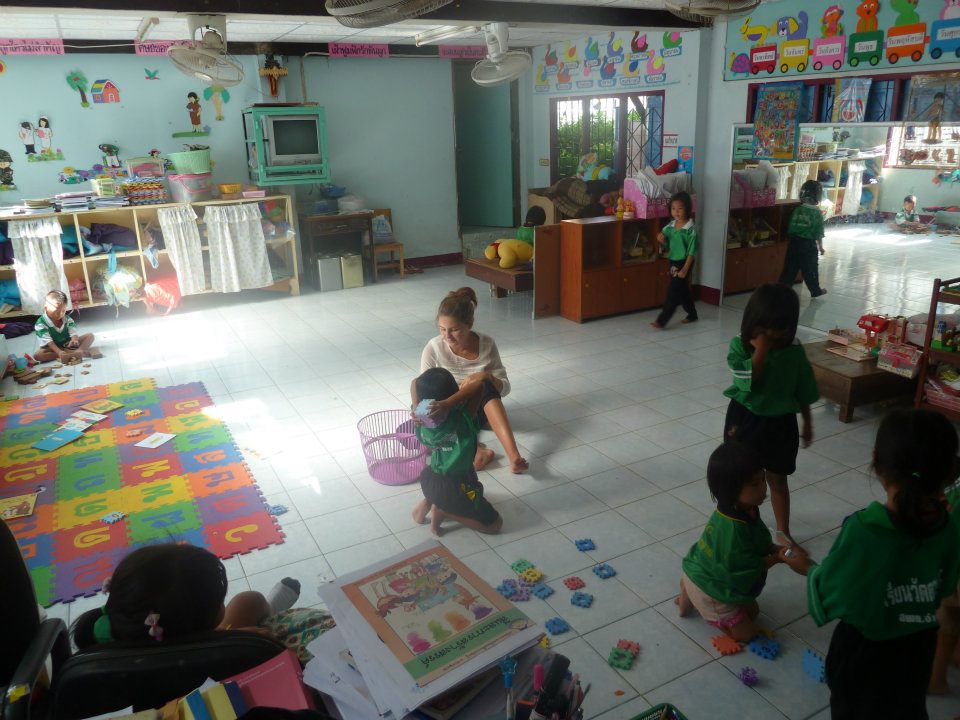
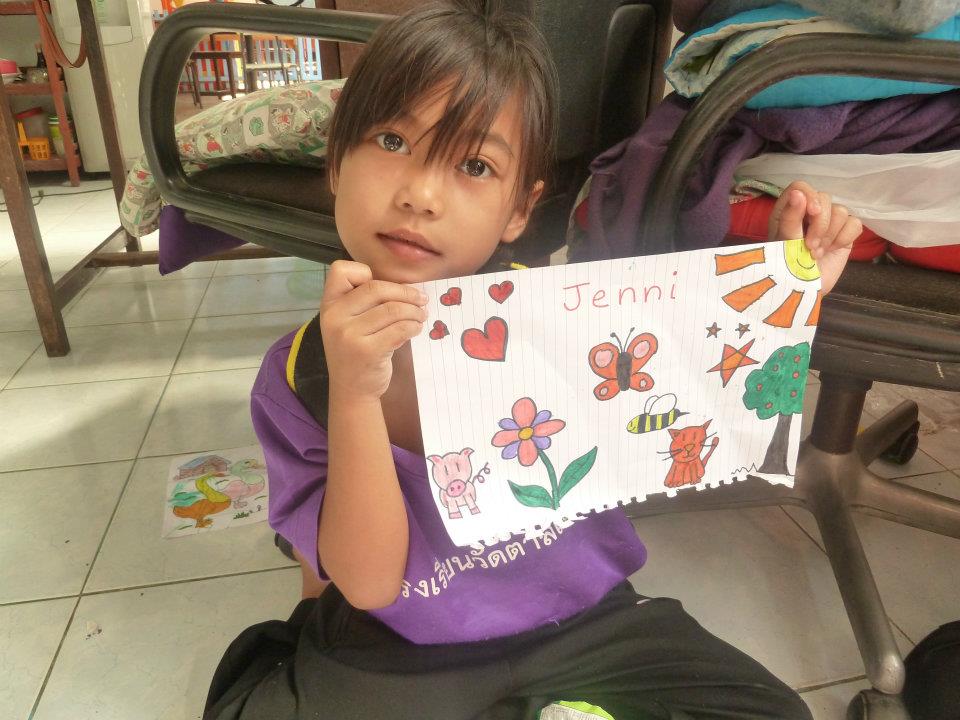
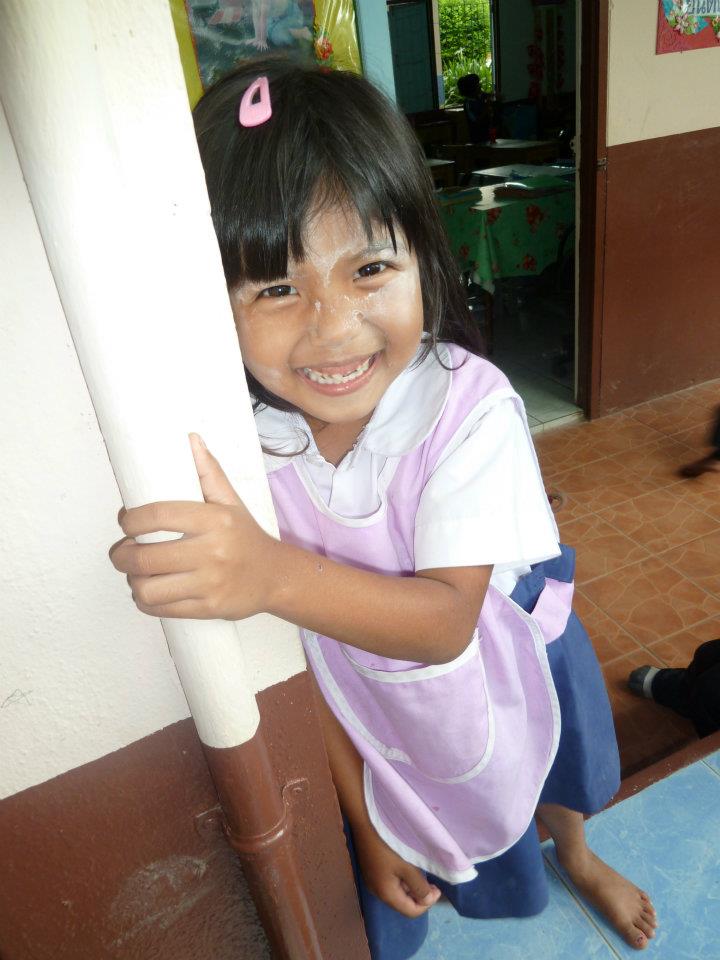
At the mid-morning break, one of the students from the older classes came around the school to hand out a small carton of milk to each child, which they sit and drink through a straw. Now this isn’t that abnormal; I remember getting milk when I was in nursery, but it’s not the act of handing out milk which so bemused me, but rather what they call milk.
The word milk, in Thai, is nom.
Yep, that’s right. The word we use to describe delicious, scrumptious food. When the bucket came around, the children would all leap up and start shouting ‘Nom! Nom!’, and I had a chuckle to myself thinking of all the Instagram posts of food I’ve captioned with the phrase ‘nomnomnom’, which to a Thai person would read ‘mikmilkmilk’.
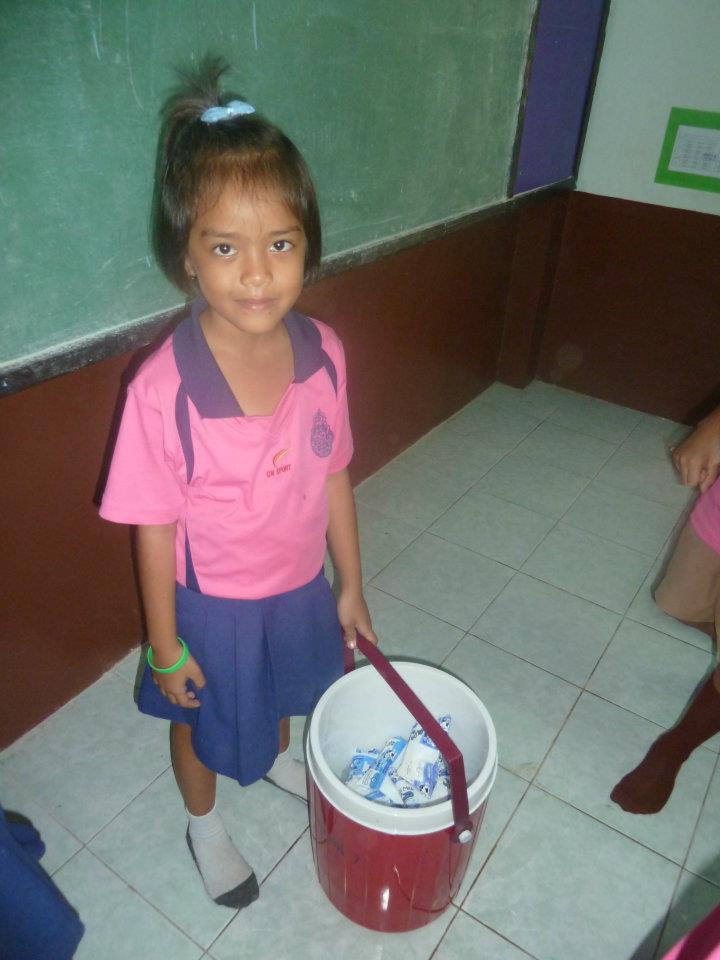
On the second day of shovelling sand, I noted that the water level was at least one foot higher than it had been the day before and looked like it was about to burst its banks any day, which only gave us more motivation to shovel as much as we could. An hour later, a small van with a satellite dish turned up and parked next to the largest pile of sand. Out stepped a very pale smartly-dressed Thai woman holding a microphone and a man holding a large camera over his shoulder. They approached the headteacher, the woman tip-toeing over the sand in her kitten heels, and chatted for a few minutes before walking over to where Cara, Gabi, June and I were stood
“Local TV station heard about you,” explained the headteacher, smiling. I noticed a bead of sweat was dripping down his forehead and he wiped it away with a cloth handkerchief from his pocket. “They so impressed English people want help us against flood. They would like film you! Ok?”
I Instantly took a small mirror out of my bag and looked at my hair. I hadn’t washed it that morning because there was quite a large scorpion looming in the shower which I didn’t fancy standing next to with my bear feet, and was wearing a mish-mash of clothes to try and protect me from the sun (imagine falling over the rails in a charity shop and wearing whatever you fall upon – that is what I looked like). The other girls were also redoing their hair and straightening out their tops, but within five minutes we were back to shovelling sand with the children, this time in front of the camera. It’s amazing how just having a camera in front of you makes you think and act completely different. Do I shovel big piles of sand so that I look like I’m a great hero? Or do I try and shovel in a ladylike way (if there is such a thing)? Do I look at the camera? Are my arms going to be wobbling lots while I’m lifting the spade? Do I smile and look friendly, or do I keep a straight face and look like I’m concentrating?
We answered a few questions and posed for some photos, and then returned to shovelling as the camera crew drove off. The children who already treated us as if we were celebrities, now thought us invincible, almost god-like. ‘Teacher, I have sandbag here!’, ‘Teacher use mine!’, ‘Teacher you beautiful!’ – it’s amazing what Thai children can do for your ego. After another hour, we stopped shovelling and everyone cheered. There was only a small pile of sand left to finish tomorrow.
As we cycled up towards the porch to get off our bikes, Sumatra was shuffling out of the house with a large smile on her face, with her arms open wide.
“You! You on TV! You all superstars!” she cried, her large smile exposing several gaps where teeth once were. Apparently, she’d been watching the TV that afternoon when our faces had appeared on the local news, and had jumped up into the air, calling for Narong to come and watch. She led us into the kitchen where she’d prepared a fruit platter using dragon fruit, rambutan, and the marmite of the fruit world, durian. “Super fruits for superstars!” she said and sat and ate with us.
On our last day at the school we arrived early, ready for another day of shovelling, only to see all the sand gone. In the evening, lots of the locals had cleared away the last of the sand and finished the make-shift sandbag barrier against the river. As it was our last day at the school before we headed south to the island of Koh Samet, everyone wanted us to relax and enjoy ourselves. I looked down at my blistered hands which were weeping and was quite relieved.
Unbeknownst to us, all the children had been learning songs and dances to perform to us after the first class of the day. Girls as young as eight were wearing traditional Thai dress and dancing elegantly to bells and rums played by other children. The monk from the orphanage left the assembly and we were all handed small baskets of food as a thank you (I checked there was no fish in mine – luckily it was mostly fruit). At the end of the assembly, the children ran up to us and held our hands, hugging our legs, asking to be in photos with us, and begging us not to leave. We’d only been teaching at the school for a few weeks, but I felt like I’d been there for years, and moreover had felt like we’d truly made an impact on everyone at the school.
A few weeks later when we were home, we were messaged on Facebook by Will, our Thai translator who’d been with us for most of the trip (his real name was Damrong, but he wanted a more westerner name to use for work, and so used his favourite film ‘Free Willy’ as inspiration). He told us that despite our best efforts, the river flooded, and the whole ground floor of the school was underwater. He sent a photo showing the front of the school where we’d been only weeks before – brown muddy waters lapped up against the first floor and several school children were floating past on tyres. I thought of all the children in the orphanage who slept on the ground floor and wondered where they were now, all of the houses we cycled past that were at low level, and even our hosts Sumatra and Narong, wondering where they were and if their house was okay.
I’ve since learnt that the flooding was triggered by the landfall of Tropical Storm Nock-ten, and affected 13.6 million people in total, and killing 813. 65 of Thailand’s 76 provinces were declared flood disaster zones, and over 20,000 square kilometres of farmland was damaged. I couldn’t believe that a country I’d seen so gloriously, full of humble and welcoming people had suffered so much destruction. I was, however, very thankful that our trip was timed when it was and not a few weeks later.
In truth, I couldn’t remember the name of the school When I started writing this article. I tried googling ‘primary schools in Angthong’ and was brought up around 10 results. I used the little yellow man feature in Google Maps to drop onto the roads and look around, and I tried to match the roads to the route we cycled every morning to school. Eventually I found Wat Tan Ched Cho School and all the memories came flooding back. I could zoom right in to the entrance, to the bit of road where we shovelled sand, to the orphanage round the side, and I was so pleased to see that it looked like it was doing so well. New buildings had been built, and even a basketball court on the field which had flooded while we were there. I’d been so sad to learn of how devastating the floods had been, but it was warming to see that the community is thriving better than ever.
